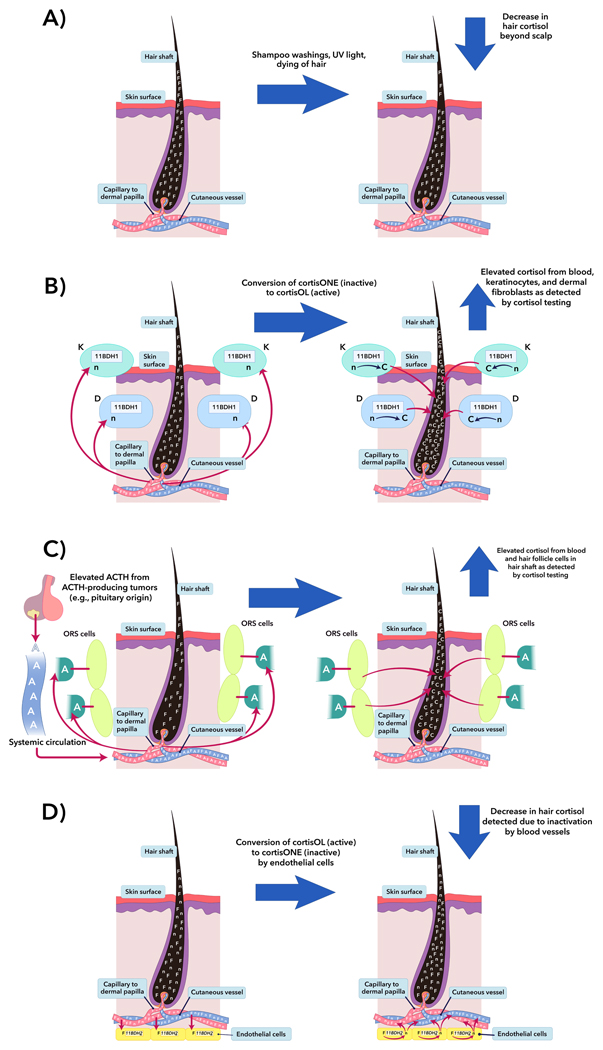Fig. 3.
Potential confounding factors in hair cortisol of CS patients. For simplicity, it is assumed that lipophilic cortisol diffuses from vessel to hair shaft via simple diffusion, similar to how illicit drugs are suspected of being incorporated into hair [45,46]. (A) Excessive shampoo washings and hair dyeing [28,29] can leach cortisol from hair, and prolonged exposure to UV light causes photo-degradation or cross-linking of glucocorticoid molecules [30], decreasing the quantification of cortisol measured in hair. (B) Assuming that skin has local HPA-like activity and appropriate negative feedback loops [33,36], the production and dynamics of locally-synthesized CRH and ACTH should be negligible under systemic suppression in chronic hypercortisolism as in murine models [47]. As may be seen in adrenal tissue in ACTH-dependent CS, in vitro studies of cultured skin sections have shown doubling to tripling of cortisol production after exposure to ACTH [48]. Human epidermal keratinocytes (K) and dermal fibroblasts (D) contain 11-beta-hydroxysteroid dehydrogenase (11BDH) type 1 (11BDH1), which can convert cortisone (inactive) to cortisol (active). In the K and D cells, 11BDH1 is site-dependent and is up-regulated with age, exposure to sunlight, and exposure to glucocorticoids [35,49], and the mechanisms causing increases in cutaneous cortisol in aging persons, such as increased 11BDH1 activity and expression, [49] might also occur in CS patients. The actual change in total hair cortisol by the increase of 11BDH1 kinetics from glucocorticoids in hypercortisolism has not been evaluated. (C) Of the hair follicle components in humans, the keratinocytes of the outer root sheath (ORS) cells possess the ability to produce cortisol after in vitro exposure to CRH and ACTH [33]. Under stimulation from excess systemic ACTH from any cause, ORS cells may locally synthesize cortisol, potentially causing an elevation of total cortisol detected in the hair shaft beyond expected from adrenal-synthesized cortisol. (D) Arterioles feeding the hair bulb express 11BDH type 2 (11BDH2) [37], which may deactivate systemic cortisol to cortisone and potentially lowering the cortisol detected in hair. In hypercortisolemic states, homeostasis is maintained by increased glucocorticoid catabolism, which is probably higher in ectopic CS than CD, likely due to higher cortisol levels in ectopic CS than CD [50]. Therefore, similarly in the skin, cutaneous 11BDH2 might also significantly reduce systemically- and locally-produced cortisol, and this enzyme might have a large role in the expected results in our CS group. This figure was designed using the program, Adobe Illustrator® CS6. F=systemically-produced hydrocortisol, n=hydrocortisone, C=locally-produced hydrocortisol, and A=systemically-produced ACTH.

